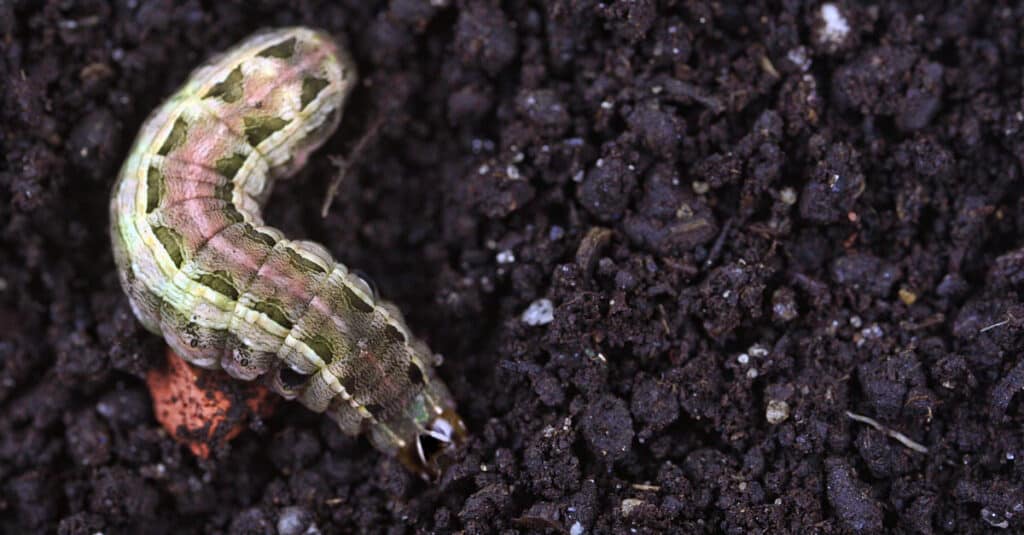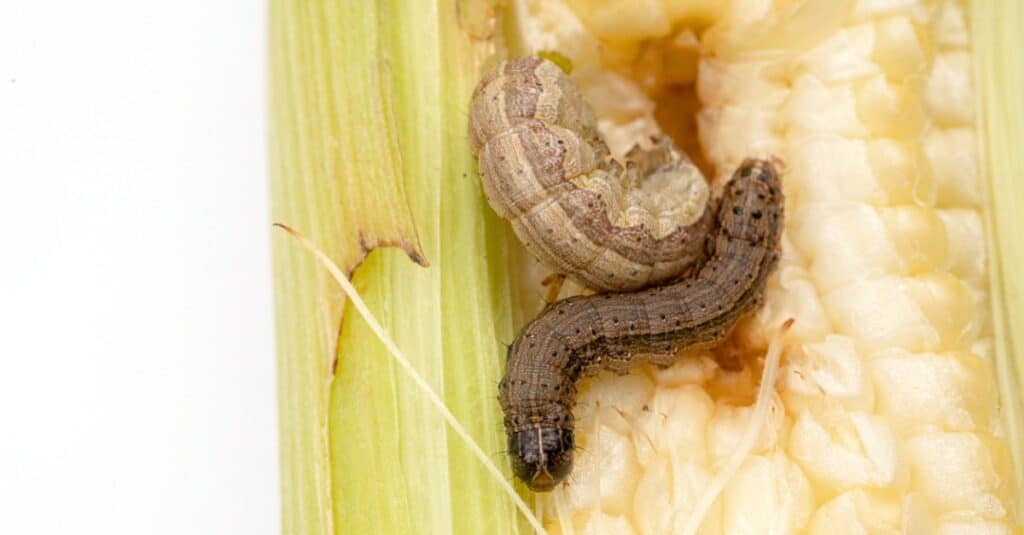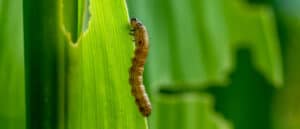Armyworms are infamous for their destructive “tendencies.” They are one of the biggest enemies of crops and grasses. Today we’ll tell you what armyworms are, what they eat, and whether anything eats them. Because their diet depends on their life cycle stage, you’ll also learn how and where they lay eggs. Moreover, we’ll share tips on preventing armyworms or checking if your lawn is infected.
What Are Armyworms?

Northern armyworms can be found in India, Japan, China, Australia, and New Zealand.
©kale kkm/Shutterstock.com
The most common armyworm types are classified into two genera. Two armyworm species are part of the Spodoptera genus. These are the African armyworm (Spodoptera exempta) and the fall armyworm (Spodoptera frugiperda). Two other armyworm species are part of the Mythimna genus. These are the true armyworm moth (Mythimna unipuncta), also called common armyworm, rice armyworm, or white-speck moth, and the northern armyworm (Mythimna separata), also called oriental armyworm, or rice ear-cutting caterpillar.
African armyworms can be found in Africa and Asia’s grasslands. They inhabit tropical and subtropical habitats with dense vegetation or nearby cereal crops. They are common in Tanzania, Uganda, Ethiopia, Kenya, Somalia, Zimbabwe, Zambia, South Africa, Southeast Asia, New Zealand, and Australia.
Fall armyworms are native to the South American and eastern and central North American continents. Because they cannot survive low temperatures during winter, they’re most common in southeastern U.S. states. However, they’ve spread to other continents in the last decade, including Africa, Europe, and Asia.
True armyworm moths are nocturnal agricultural pests in the Noctuidae family. They live in the Americas, central Africa, western Asia, and southern Europe. They’re common in northern Canada and areas east of the Rocky Mountains.
Northern armyworms can be found in India, Japan, China, Australia, and New Zealand.
All these species are called armyworms because of their marching, invasive behavior, which means that they move in a line across a lawn, “marching” forward while eating.
What Do Armyworms Eat?

Armyworm larvae eat young leaf tissue and green stems.
©natthawut ngoensanthia/Shutterstock.com
Armyworms have different stages of life, and their diet changes depending on what stage they are in. Armyworm larvae eat young leaf tissue and green stems. Most adult armyworms eat flower nectar or ripe fruit. Armyworms are a threat to crops only during their larval stage.
Although they’re generally herbivores, armyworms may sometimes become omnivores if they practice cannibalism.
African armyworm larvae primarily feed on Poaceae, also called Gramineae – a family of monocotyledonous flowering plants or simply grasses. These include bamboo, cereal grasses, or grasses cultivated in lawns or pastures. Young caterpillars feed on wheat and oat seedlings by eating the upper and lower parts of the plant first. They are known to feed on maize, sorghum, millet, rice, and other grasses. Adult African armyworms eat plant nectar.
Fall armyworm caterpillars feed on grain crops and grasses. They’re known to eat more than 80 different types of plants. When food is scarce, they may practice cannibalism. Adult moths feed on flower nectar.
True armyworm moth larvae eat numerous Gramineae species and other crops. These include oats, rice, sugarcane, wheat, artichoke, beans, cabbage, celery, cucumber, onion, parsley, carrot, and sweet potato. Adults feed on flower nectar and ripe fruit.
Northern armyworms commonly eat sorghum, wheat, rice, and barley.
Do Armyworms Eat Oats and Vegetables?
Yes, armyworms feed on oats. If they run out of food in cereal, wheat, or grass fields, they’ll move to eating vegetables!
A List of Foods Armyworms Eat
Here’s a list of foods armyworms eat:
- Leaf tissue
- Green stems
- Flower nectar
- Ripe fruit
- Bamboo
- Wheat
- Oat
- Maize
- Sorghum
- Rice
What Is the Lifecycle of an Armyworm?
Most armyworms have 2 – 3 generations per year. They usually lay the egg masses on grasses or cereals, in the folds of leaves, although this depends on the species preferences. African armyworm females, for example, lay roughly 1,000 eggs in their life, with an average of 150 per night. Fall armyworm females lay up to 1,500 eggs over their life spans. If the population is abundant, fall armyworms will lay their eggs anywhere.
What Eats Armyworms?

Armyworms can be affected by bacterial and fungal diseases.
©Frank Reiser/Shutterstock.com
Although they’re destructive to crops and are the main cause of serious infestations, armyworms can also fall prey to other species. For example, ground beetles that inhabit the same habitat feed on armyworm larvae. Other predators include ants, bugs, spiders, wasps, flies, birds, rodents, and skunks. There’s even a blackbird called bobolink, often called an armyworm bird because it primarily feeds on armyworms. Crows and starlings also eat armyworms.
Besides predators, armyworms may get infected and killed by wasps and fly parasitoid species, such as Meteorus autographae and Cotesia marginiventris. Armyworms can also be affected by bacterial and fungal diseases, especially the Metarhizium anisopliae fungus.
How To Prevent Armyworm Infestation?
Armyworms are so good at eating that they can destroy your fields within days! So here’s what you should do if you fear an infestation.
First, you should regularly check your lawn for brown grass patches, grass that has been eaten, or birds picking at your yard because they often feed on armyworms.
You should regularly mow and water your lawn and remove grassy weeds and thatch to “destroy” favorable armyworm habitats. An idea that could also work is shutting off the outdoor light at night. This way, moths won’t be attracted by the light and won’t lay eggs on your lawn.
If you suspect an infestation, you should do the soap-water test. Mix soap with water and pour it over a small part of the lawn. If armyworms are there, they’ll come to the surface.
Why Is It Difficult To Control Armyworms?

Armyworms are extremely difficult to control because they can develop resistance to pesticides.
©iStock.com/ossyugioh
Armyworms are extremely difficult to control because they can develop resistance to pesticides. Besides this, a study shows that fall armyworms are polyphagous (feed on several hosts) and trans-boundary (migrate easily through trade and natural winds), multiply fast, have short life cycles, and lack diapause growth phases (a pause in developmental growth due to unfavorable conditions). Moreover, they breed at a high rate.
Up Next:
The photo featured at the top of this post is © kale kkm/Shutterstock.com
Sources
- Business Insider, Available here: https://www.businessinsider.com/army-worms-how-to-prevent-armyworms-treatment-lawn-grass-infestation-2021-8
- Frontiers, Available here: https://www.frontiersin.org/articles/10.3389/fevo.2021.735924/full
- GardenTech, Available here: https://www.gardentech.com/insects/armyworms
- Texas A&M Agrilife, Available here: https://citybugs.tamu.edu/factsheets/landscape/lawns/ent-1007/
Thank you for reading! Have some feedback for us? Contact the AZ Animals editorial team.






